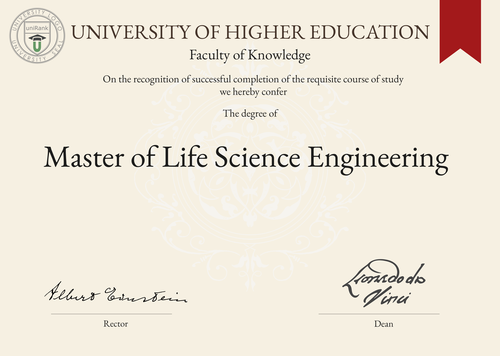
Master of Life Science Engineering (M.L.S.E.)
Guide to University Programs/Courses
Master of Life Science Engineering (M.L.S.E.)

Program/Course Name
Master of Life Science EngineeringProgram/Course Abbreviation
M.L.S.E.Duration Range
The duration of the program typically ranges from 1 to 2 years.Tuition range
The tuition fees for the program vary depending on the chosen country and university. Please note that tuition fees can range from affordable to expensive.Overview
The Master of Life Science Engineering program is designed to provide students with a comprehensive understanding of the principles and applications of life sciences in engineering. It combines knowledge from various disciplines such as biology, chemistry, physics and engineering to address challenges in the field of life sciences.Curriculum Overview by Year
The curriculum of the program is structured to cover both theoretical knowledge and practical skills. The coursework is divided into different modules, focusing on subjects like biochemistry, biotechnology, genetics, biomedical engineering and more. Students also have the opportunity to engage in research projects and internships to gain hands-on experience.Key Components
The key components of the Master of Life Science Engineering program include in-depth study of life sciences, application of engineering principles, laboratory work, research projects and internships. Students also develop critical thinking, problem-solving and communication skills.Career Prospects
Graduates of the program have a wide range of career opportunities in various industries. They can work in pharmaceutical companies, biotechnology firms, research institutions, healthcare organizations and government agencies. Job roles may include research scientist, bioengineer, biotechnologist, quality control specialist and more.Salary Expectations
The salary expectations for Master of Life Science Engineering graduates vary depending on factors such as location, industry, job role and level of experience. Generally, graduates can expect competitive salaries in the field. For a more accurate understanding of salary expectations, you can utilize the Job Sites Search Engine, from our sister site jobRank, which searches over 4,600 job sites worldwide. Make sure to specify not only the job title but also the country you are interested in.Conclusions
It is important to note that the duration, tuition fees, curriculum, key components, career prospects and salary expectations of the Master of Life Science Engineering program can vary based on the chosen country or location for studying the program, as well as the chosen university. Prospective students are advised to research and compare different universities and countries to find the best fit for their academic and career goals.Furthermore, visitors interested in pursuing this specific degree can utilize the uniRank World Universities Search Engine to search for universities offering the Master of Life Science Engineering program worldwide. This search engine provides a comprehensive database of universities, allowing individuals to explore their options and make informed decisions about their education.World Universities Search Engine
search for Master of Life Science Engineering (M.L.S.E.) and add the Location (country, state etc.) or specific University you are interested in studying at.
Query examples:
- Master of Life Science Engineering (M.L.S.E.) United States
- Master of Life Science Engineering (M.L.S.E.) United Kingdom online
- Master of Life Science Engineering (M.L.S.E.) Australia international students
- Master of Life Science Engineering (M.L.S.E.) University of California
- Master of Life Science Engineering (M.L.S.E.) University of London tuition fees
- Master of Life Science Engineering (M.L.S.E.) University of Sydney scholarships